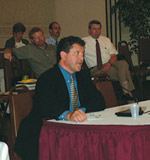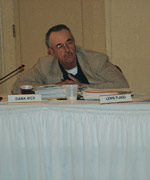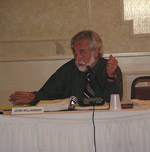|
Mid-water Trawler Wake Up Call
by Paul Molyneaux
A flurry of bycatch incidents, in which mid-water herring trawlers landed as much as 24 thousand pounds of juvenile haddock per trip, has forced regulators to rein in New England’s most productive, but controversial fishing boats. Since February 1998, mid-water herring trawlers, single boats and pair trawlers — 2 boats that pull one net — have operated within a Special Access Program (SAP), which allows gear deemed “incapable of catching groundfish” to be used in areas closed to groundfishing. But in July and August of this year, at least six mid-water trawlers from Maine, New Hampshire and Massachusetts, were investigated for landing juvenile haddock.
 “This is a new problem. We’re unsure of ourselves.” “This is a new problem. We’re unsure of ourselves.”
— Andy Cohen, NOAA’s chief enforcement officer for the NE Region
 “If bycatch is a problem in permanent closed areas, why would you think that there isn’t a problem in all closed areas.” “If bycatch is a problem in permanent closed areas, why would you think that there isn’t a problem in all closed areas.”
— Rich Ruais, director East Coast Tuna Association
 We have just cut every groundfisherman in New England....We can’t turn around and give those fish to the mid-water boats. We can’t do it.” We have just cut every groundfisherman in New England....We can’t turn around and give those fish to the mid-water boats. We can’t do it.”
— Dana Rice, NEFMC member
 “It appears to me that we are looking at two problems, and we don’t know which is the real problem.” “It appears to me that we are looking at two problems, and we don’t know which is the real problem.”
— John Williamson, NEFMC member
|
At the September 16, 2004, meeting of the New England Fishery Management Council (NEFMC) representatives from the groundfish industry, the purse seine sector of the herring fishery, recreational fishermen, tuna fishermen, and environmentalists, called for severe limits on mid-water trawler activity. At the very least, most of these groups wanted the mid-water boats out of all areas closed to groundfishing.
Representatives from the herring industry, the council — including Sally McGee of Environmental Defense — the National Oceanic and Atmospheric Administration (NOAA), and the Maine DMR called for a bycatch allowance that would allow mid-water boats to continue fishing, in all areas. But, by the end of the day, council members voted 8 to 4 to propose revoking the exempted gear status that has granted the mid-water boats unfettered access to groundfish sanctuaries.
The September meeting — that may cost the mid-water trawlers their official designation as a clean fishing gear type — revealed a great deal about the state of enforcement and oversight in the herring fishery.
Enforcement
Andy Cohen, NOAA’s chief enforcement officer for the Northeast Region, opened his statement to the council with the emphatic assertion that contrary to public perception, his department was taking action against the mid-water vessels that had been found with haddock bycatch. He presented the data from dockside monitoring, often extrapolations from a few hundred pounds sampled out of hundreds of thousands of pounds of herring, and defended his decision not to seize the catches of the mid-water boats, pointing out that several hundred thousand pounds of herring can be a problem to handle. Cohen said that he usually seized a catch, holding the proceeds from its sale in escrow, when he expected a fine. “This is a new problem,” he said. “We’re unsure of ourselves.”
Sale of the catch would also be difficult within the insular herring industry, where a handful of buyers control the market, and product quality and value can decrease sharply over the course of a day.
Cohen said he sent the case files to the Counsel General (CG), who could issue a fine known as a NOVA (Notice of Violation Assessment) or a warning. Many at the meeting expected word from the CG, but, according to Cohen, they were “going to look at the problem globally before taking action.”
“Does any other fishery get this kind of special treatment?” asked Glen Delaney, lobbyist for Northeast Seafood, a group representing about 300 outraged groundfishermen from Massachusetts and New Hampshire.
“It’s not special treatment,” said Cohen. “I’ve asked the Counsel General to expedite these cases.”
According to Chuck Juliand, senior enforcement attorney for the CG, he has put the mid-water trawler cases on the fast track and intends to analyze them as a group. “If I think it’s egregious, intentional or reckless, I’ll take action,” Juliand said, of the bycatch incidents. “But I’m going to make sure this office doesn’t get used as a club by people who are against mid-water trawlers. We’ll look at the regulations and enforce them.” Juliand predicted a decision within a month “if all else remains quiet,” three months at the outside.
Observer Coverage and Dockside Monitoring
Dave Potter, director of what many consider the grossly under-funded NOAA observer program, presented the council with what data he had. Potter explained how observers would take one basket from the chute as fish came aboard a herring vessel and log any bycatch as they measured each herring. “The sampling depends on how fast the fish come aboard,” he said. A host of other variables, including the speed of the observer, could also affect the data. While the incidents that brought the heat onto the mid-water trawlers involved small juvenile haddock, Potter’s data reflected the take of as many as 6,500 pounds of mature haddock. As he explained the sampling process, many council members expressed their frustration.
“I have to tell you I’m not impressed with the data I’ve seen today,” said council member John Williamson. “It appears to me that we are looking at two problems, and we don’t know which is the real problem.”
Rick Ruais, executive director of the East Coast Tuna Association (ECTA), asked if observers had access to the wheelhouse to find out how close to bottom the net was being towed.
“We don’t collect that data,” said Potter.
The council made a general call for better observer coverage and dockside monitoring.
Bycatch: A Problem of Abundance
According to Dr. Bill Overholtz, fisheries biologist with the Northeast Fisheries Science Center in Woods Hole, Mass, the already high biomass of 75 million haddock is expected to increase to 400 million fish by next year. “Haddock bycatch could become a big problem in all fisheries,” he said.
Faced with uncertainty regarding interactions between burgeoning haddock stocks and other fisheries, the council also voted to create a committee to study the issue.
In the meantime, mid-water trawler representatives faced with the current zero tolerance on landing groundfish, called for a bycatch allowance that would allow boats to keep fishing when their catches contained small haddock. But council member Dana Rice voiced adamant opposition to such a move. “We have just cut every groundfisherman in New England so they can barely make it. We can’t turn around and give those fish to the mid-water boats. We can’t do it.”
“It’s obvious this gear is capable of catching groundfish,” said Council member Tom Hill. “We have a moral obligation to the people who have sacrificed to rebuild groundfish. We have to send them the message that this will not be tolerated.”
Hill made a motion to ask the NEFMC staff to include language in the latest adjustment to the multispecies management plan — Framework 40B — that would ban mid-water gear in groundfish closed areas. Hill amended the motion to specify that the ban would include both mid-water and purse seine boats, and would be limited to permanent closed areas on Georges Bank and in the Western Gulf of Maine.
Tom Nies, fisheries analyst with the NEFMC, suggested creating a cap on bycatch, and council member Sally McGee, of Environmental Defense, made a motion to that effect, but it went nowhere. Lew Flagg, deputy commissioner of Maine’s DMR, expressed reluctance to kick the mid-water boats out of closed areas. Flagg pointed out that the mid-water boats might shift effort into the inshore waters of Area 1A, where the herring resource is already fully exploited.
“I don’t think we’ve seen evidence that purse seiners are the problem,” said council member John Williamson. But not wanting to stall the process, Hill agreed to include purse seines in the ban.
Opposition to Hill’s motion also came from some of the mid-water trawler’s fiercest critics. Niaz Dorry, political director of an environmental watchdog group called Clean Catch, and ECTA’s Rich Ruais both testified that the proposed action did not go far enough in addressing a long-existent problem.
“This gear does not belong in the fishery,” said Dorry, calling for an outright ban on mid-water gear. Rich Ruais said he believed there was a place for mid-water gear. “I think in the winter squid and mackerel fisheries this gear can fish cleanly,” he said. But he remained emphatic that it should be banned from all groundfish closed area, including rolling and seasonal closures. “If bycatch is a problem in permanent closed areas, why would you think that there isn’t a problem in all closed areas?” Ruais asked.
Hill called his proposal to ban herring fishing in the permanent closed areas, “a short-term solution to a long-term problem.” Hill said it was “a first step in addressing the problem, and further measures can be considered later.”
Mary Beth Tooley, spokesperson for several mid-water trawler owners, called the motion premature. After the vote in favor of the motion and the official ending of the meeting, Tooley returned to the microphone to tell the council that their action was “unconscionable.”
In spite of his reservations, Ruais considered passage of the motion a preliminary victory for the various organizations that want to limit mid-water trawlers’ access to closed areas, and the nearshore waters of Area 1A. “The 8 to 4 vote was comforting,” said Ruais. “It tells us that a large majority of council members understand that mid-water trawl gear is capable of catching groundfish. That’s important.”
|





